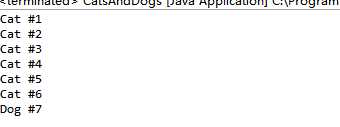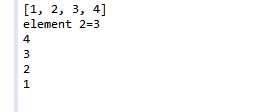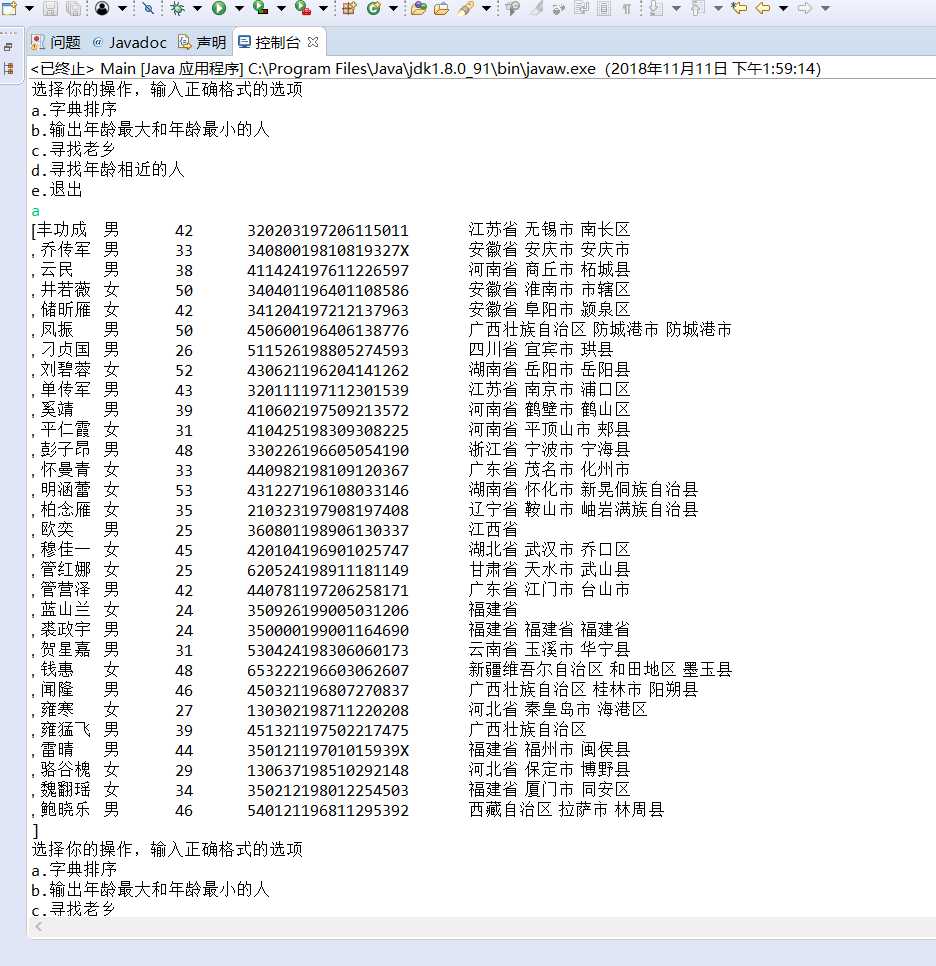标签:seconds 老师 art math argv else compareto tin address
实验十一 集合
1、实验目的与要求
(1) 掌握Vetor、Stack、Hashtable三个类的用途及常用API;
(2) 了解java集合框架体系组成;
(3) 掌握ArrayList、LinkList两个类的用途及常用API。
(4) 了解HashSet类、TreeSet类的用途及常用API。
(5)了解HashMap、TreeMap两个类的用途及常用API;
(6) 结对编程(Pair programming)练习,体验程序开发中的两人合作。
2、实验内容和步骤
实验1: 导入第9章示例程序,测试程序并进行代码注释。
测试程序1:
l 使用JDK命令运行编辑、运行以下三个示例程序,结合运行结果理解程序;
l 掌握Vetor、Stack、Hashtable三个类的用途及常用API。
|
//示例程序1 import java.util.Vector;
class Cat { private int catNumber;
Cat(int i) { catNumber = i; }
void print() { System.out.println("Cat #" + catNumber); } }
class Dog { private int dogNumber;
Dog(int i) { dogNumber = i; }
void print() { System.out.println("Dog #" + dogNumber); } }
public class CatsAndDogs { public static void main(String[] args) { Vector cats = new Vector(); for (int i = 0; i < 7; i++) cats.addElement(new Cat(i)); cats.addElement(new Dog(7)); for (int i = 0; i < cats.size(); i++) ((Cat) cats.elementAt(i)).print(); } } |
|
//示例程序2 import java.util.*;
public class Stacks { static String[] months = { "1", "2", "3", "4" };
public static void main(String[] args) { Stack stk = new Stack(); for (int i = 0; i < months.length; i++) stk.push(months[i]); System.out.println(stk); System.out.println("element 2=" + stk.elementAt(2)); while (!stk.empty()) System.out.println(stk.pop()); } } |
|
//示例程序3 import java.util.*;
class Counter { int i = 1;
public String toString() { return Integer.toString(i); } }
public class Statistics { public static void main(String[] args) { Hashtable ht = new Hashtable(); for (int i = 0; i < 10000; i++) { Integer r = new Integer((int) (Math.random() * 20)); if (ht.containsKey(r)) ((Counter) ht.get(r)).i++; else ht.put(r, new Counter()); } System.out.println(ht); } } |
1
package a; import java.util.Vector; class Cat { private int catNumber; Cat(int i) { catNumber = i; } void print() { System.out.println("Cat #" + catNumber); } } class Dog { private int dogNumber; Dog(int i) { dogNumber = i; } void print() { System.out.println("Dog #" + dogNumber); } } public class CatsAndDogs { public static void main(String[] args) { Vector cats = new Vector(); Vector dogs = new Vector(); for (int i = 0; i < 7; i++) cats.addElement(new Cat(i)); cats.addElement(new Dog(7)); for (int i = 0; i < cats.size(); i++) if(cats.elementAt(i)instanceof Cat)//做出判断能否被转换 { ((Cat) cats.elementAt(i)).print(); } else ((Dog) cats.elementAt(i)).print(); } }

2
package b; import java.util.*; public class Stacks {//stack是java里的一个集合类,用于模拟一个堆栈,存放的信息是后进的元素先出 static String[] months = { "1", "2", "3", "4" }; public static void main(String[] args) { Stack stk = new Stack(); for (int i = 0; i < months.length; i++) stk.push(months[i]); System.out.println(stk); System.out.println("element 2=" + stk.elementAt(2)); while (!stk.empty()) System.out.println(stk.pop()); } }

3
package c; import java.util.*; class Counter { int i = 1; public String toString() { return Integer.toString(i); } } public class Statistics { public static void main(String[] args) { Hashtable ht = new Hashtable();//相当于array,里面可以存放大多数类型数据,在不知array的情况下用hashtable 比较方便;(键值类) for (int i = 0; i < 10000; i++) { Integer r = new Integer((int) (Math.random() * 20));//生成20以内的随机数 if (ht.containsKey(r))//Hashtable常用方法,判断r是不是键值的一个方法 ((Counter) ht.get(r)).i++; else ht.put(r, new Counter()); } System.out.println(ht); } }

测试程序2:
l 使用JDK命令编辑运行ArrayListDemo和LinkedListDemo两个程序,结合程序运行结果理解程序;
|
import java.util.*;
public class ArrayListDemo { public static void main(String[] argv) { ArrayList al = new ArrayList(); // Add lots of elements to the ArrayList... al.add(new Integer(11)); al.add(new Integer(12)); al.add(new Integer(13)); al.add(new String("hello")); // First print them out using a for loop. System.out.println("Retrieving by index:"); for (int i = 0; i < al.size(); i++) { System.out.println("Element " + i + " = " + al.get(i)); } } } |
|
import java.util.*; public class LinkedListDemo { public static void main(String[] argv) { LinkedList l = new LinkedList(); l.add(new Object()); l.add("Hello"); l.add("zhangsan"); ListIterator li = l.listIterator(0); while (li.hasNext()) System.out.println(li.next()); if (l.indexOf("Hello") < 0) System.err.println("Lookup does not work"); else System.err.println("Lookup works"); } } |
package b; import java.util.*; public class ArrayListDemo { public static void main(String[] argv) { ArrayList al = new ArrayList();//ArrayList是实现了基于动态数组的数据结构;ArrayList要移动数据. // Add lots of elements to the ArrayList... al.add(new Integer(11)); al.add(new Integer(12)); al.add(new Integer(13)); al.add(new String("hello")); // First print them out using a for loop. System.out.println("Retrieving by index:"); for (int i = 0; i < al.size(); i++) { System.out.println("Element " + i + " = " + al.get(i)); } } }

2
package cc; import java.util.*; public class LinkedListDemo { public static void main(String[] argv) { LinkedList l = new LinkedList();//LinkedList基于链表的数据结构;LinkedList要移动指针 l.add(new Object()); l.add("Hello"); l.add("zhangsan"); ListIterator li = l.listIterator(0); while (li.hasNext()) System.out.println(li.next()); if (l.indexOf("Hello") < 0) System.err.println("Lookup does not work"); else System.err.println("Lookup works"); } }

l 在Elipse环境下编辑运行调试教材360页程序9-1,结合程序运行结果理解程序;
l 掌握ArrayList、LinkList两个类的用途及常用API。
package linkedList; import java.util.*; /** * This program demonstrates operations on linked lists. * @version 1.11 2012-01-26 * @author Cay Horstmann */ public class LinkedListTest//LinkedList基于链表的数据结构;LinkedList要移动指针 { public static void main(String[] args) { List<String> a = new LinkedList<>(); a.add("Amy"); a.add("Carl"); a.add("Erica"); List<String> b = new LinkedList<>(); b.add("Bob"); b.add("Doug"); b.add("Frances"); b.add("Gloria"); // merge the words from b into a ListIterator<String> aIter = a.listIterator(); Iterator<String> bIter = b.iterator(); while (bIter.hasNext()) { if (aIter.hasNext()) aIter.next(); aIter.add(bIter.next()); } System.out.println(a); // remove every second word from b bIter = b.iterator(); while (bIter.hasNext()) { bIter.next(); // skip one element if (bIter.hasNext()) { bIter.next(); // skip next element bIter.remove(); // remove that element } } System.out.println(b); // bulk operation: remove all words in b from a a.removeAll(b); System.out.println(a); } }

测试程序3:
l 运行SetDemo程序,结合运行结果理解程序;
|
import java.util.*; public class SetDemo { public static void main(String[] argv) { HashSet h = new HashSet(); //也可以 Set h=new HashSet() h.add("One"); h.add("Two"); h.add("One"); // DUPLICATE h.add("Three"); Iterator it = h.iterator(); while (it.hasNext()) { System.out.println(it.next()); } } } |

l 在Elipse环境下调试教材365页程序9-2,结合运行结果理解程序;了解HashSet类的用途及常用API。
package set; import java.util.*; /** * This program uses a set to print all unique words in System.in. * @version 1.12 2015-06-21 * @author Cay Horstmann */ public class SetTest { public static void main(String[] args) { Set<String> words = new HashSet<>(); // HashSet是实现Set接口的一个类, long totalTime = 0; try (Scanner in = new Scanner(System.in)) { while (in.hasNext()) { String word = in.next(); long callTime = System.currentTimeMillis(); words.add(word); callTime = System.currentTimeMillis() - callTime; totalTime += callTime; } } Iterator<String> iter = words.iterator(); for (int i = 1; i <= 20 && iter.hasNext(); i++) System.out.println(iter.next()); System.out.println(". . ."); System.out.println(words.size() + " distinct words. " + totalTime + " milliseconds."); } }
l 在Elipse环境下调试教材367页-368程序9-3、9-4,结合程序运行结果理解程序;了解TreeSet类的用途及常用API。
package treeSet; import java.util.*; /** * This program sorts a set of item by comparing their descriptions. * @version 1.12 2015-06-21 * @author Cay Horstmann */ public class TreeSetTest//TreeSet的存储原理:底层是通过二叉树的数据结构实现的,存储规则:左小右大,当添加元素的时候依靠的是元素的comparable方法来添加元素 { public static void main(String[] args) { SortedSet<Item> parts = new TreeSet<>(); parts.add(new Item("Toaster", 1234)); parts.add(new Item("Widget", 4562)); parts.add(new Item("Modem", 9912)); System.out.println(parts); NavigableSet<Item> sortByDescription = new TreeSet<>( Comparator.comparing(Item::getDescription)); sortByDescription.addAll(parts); System.out.println(sortByDescription); } }

测试程序4:
l 使用JDK命令运行HashMapDemo程序,结合程序运行结果理解程序;
|
import java.util.*; public class HashMapDemo { public static void main(String[] argv) { HashMap h = new HashMap(); // The hash maps from company name to address. h.put("Adobe", "Mountain View, CA"); h.put("IBM", "White Plains, NY"); h.put("Sun", "Mountain View, CA"); String queryString = "Adobe"; String resultString = (String)h.get(queryString); System.out.println("They are located in: " + resultString); } } |
package treeSet; import java.util.*; public class HashMapDemo { public static void main(String[] argv) { HashMap h = new HashMap();//HashMap通过hashcode对其内容进行快速查找 // The hash maps from company name to address. h.put("Adobe", "Mountain View, CA"); h.put("IBM", "White Plains, NY"); h.put("Sun", "Mountain View, CA"); String queryString = "Adobe"; String resultString = (String)h.get(queryString); System.out.println("They are located in: " + resultString); } }

l 在Elipse环境下调试教材373页程序9-6,结合程序运行结果理解程序;
package map; import java.util.*; /** * This program demonstrates the use of a map with key type String and value type Employee. * @version 1.12 2015-06-21 * @author Cay Horstmann */ public class MapTest { public static void main(String[] args) { Map<String, Employee> staff = new HashMap<>();//HashMap通过hashcode对其内容进行快速查找 staff.put("144-25-5464", new Employee("Amy Lee")); staff.put("567-24-2546", new Employee("Harry Hacker")); staff.put("157-62-7935", new Employee("Gary Cooper")); staff.put("456-62-5527", new Employee("Francesca Cruz")); // print all entries System.out.println(staff); // remove an entry staff.remove("567-24-2546"); // replace an entry staff.put("456-62-5527", new Employee("Francesca Miller")); // look up a value System.out.println(staff.get("157-62-7935")); // iterate through all entries staff.forEach((k, v) -> System.out.println("key=" + k + ", value=" + v)); } }

l 了解HashMap、TreeMap两个类的用途及常用API。
:HashMap通过hashcode对其内容进行快速查找,而 TreeMap中所有的元素都保持着某种固定的顺序,如果你需要得到一个有序的结果你就应该使用TreeMap(HashMap中元素的排列顺序是不固定的)。
实验2:结对编程练习:
l 关于结对编程:以下图片是一个结对编程场景:两位学习伙伴坐在一起,面对着同一台显示器,使用着同一键盘,同一个鼠标,他们一起思考问题,一起分析问题,一起编写程序。
l 关于结对编程的阐述可参见以下链接:
http://www.cnblogs.com/xinz/archive/2011/08/07/2130332.html
http://en.wikipedia.org/wiki/Pair_programming
l 对于结对编程中代码设计规范的要求参考:
http://www.cnblogs.com/xinz/archive/2011/11/20/2255971.html
以下实验,就让我们来体验一下结对编程的魅力。
l 确定本次实验结对编程合作伙伴;
合作伙伴:马兴德(201771010117);
l 各自运行合作伙伴实验九编程练习1,结合使用体验对所运行程序提出完善建议;
建议:
//修改后: File file = new File("身份证号.txt");(将文件放入该包中更好如前代码—);
package Test; import java.io.BufferedReader; import java.io.File; import java.io.FileInputStream; import java.io.FileNotFoundException; import java.io.IOException; import java.io.InputStreamReader; import java.util.ArrayList; import java.util.Arrays; import java.util.Collections; import java.util.Scanner; public class Main{ private static ArrayList<Student> studentlist; public static void main(String[] args) { studentlist = new ArrayList<>(); Scanner scanner = new Scanner(System.in); File file = new File("D:\\身份证号.txt"); //修改后: File file = new File("身份证号.txt");(将文件放入该包中更好如前代码—) try { FileInputStream fis = new FileInputStream(file); BufferedReader in = new BufferedReader(new InputStreamReader(fis)); String temp = null; while ((temp = in.readLine()) != null) { Scanner linescanner = new Scanner(temp); linescanner.useDelimiter(" "); String name = linescanner.next(); String number = linescanner.next(); String sex = linescanner.next(); String age = linescanner.next(); String province =linescanner.nextLine(); Student student = new Student(); student.setName(name); student.setnumber(number); student.setsex(sex); int a = Integer.parseInt(age); student.setage(a); student.setprovince(province); studentlist.add(student); } } catch (FileNotFoundException e) { System.out.println("学生信息文件找不到"); e.printStackTrace(); } catch (IOException e) { System.out.println("学生信息文件读取错误"); e.printStackTrace(); } boolean isTrue = true; while (isTrue) { System.out.println("选择你的操作,输入正确格式的选项"); System.out.println("a.字典排序"); System.out.println("b.输出年龄最大和年龄最小的人"); System.out.println("c.寻找老乡"); System.out.println("d.寻找年龄相近的人"); System.out.println("e.退出"); String m = scanner.next(); switch (m) { case "a": Collections.sort(studentlist); System.out.println(studentlist.toString()); break; case "b": int max=0,min=100; int j,k1 = 0,k2=0; for(int i=1;i<studentlist.size();i++) { j=studentlist.get(i).getage(); if(j>max) { max=j; k1=i; } if(j<min) { min=j; k2=i; } } System.out.println("年龄最大:"+studentlist.get(k1)); System.out.println("年龄最小:"+studentlist.get(k2)); break; case "c": System.out.println("老家?"); String find = scanner.next(); String place=find.substring(0,3); for (int i = 0; i <studentlist.size(); i++) { if(studentlist.get(i).getprovince().substring(1,4).equals(place)) System.out.println("老乡"+studentlist.get(i)); } break; case "d": System.out.println("年龄:"); int yourage = scanner.nextInt(); int near=agenear(yourage); int value=yourage-studentlist.get(near).getage(); System.out.println(""+studentlist.get(near)); break; case "e": isTrue = false; System.out.println("退出程序!"); break; default: System.out.println("输入有误"); } } } public static int agenear(int age) { int j=0,min=53,value=0,k=0; for (int i = 0; i < studentlist.size(); i++) { value=studentlist.get(i).getage()-age; if(value<0) value=-value; if (value<min) { min=value; k=i; } } return k; } }
package Test; public class Student implements Comparable<Student> { private String name; private String number ; private String sex ; private int age; private String province; public String getName() { return name; } public void setName(String name) { this.name = name; } public String getnumber() { return number; } public void setnumber(String number) { this.number = number; } public String getsex() { return sex ; } public void setsex(String sex ) { this.sex =sex ; } public int getage() { return age; } public void setage(int age) { // int a = Integer.parseInt(age); this.age= age; } public String getprovince() { return province; } public void setprovince(String province) { this.province=province ; } public int compareTo(Student o) { return this.name.compareTo(o.getName()); } public String toString() { return name+"\t"+sex+"\t"+age+"\t"+number+"\t"+province+"\n"; } }
l 各自运行合作伙伴实验十编程练习2,结合使用体验对所运行程序提出完善建议;
建议:
1)、

(2)、

前边用了该程序以后后边子类不需要定义(b!=0)如上边1)和2)中:(2)明显多余;

l 采用结对编程方式,与学习伙伴合作完成实验九编程练习1;
package Test; import java.io.BufferedReader; import java.io.File; import java.io.FileInputStream; import java.io.FileNotFoundException; import java.io.IOException; import java.io.InputStreamReader; import java.util.ArrayList; import java.util.Arrays; import java.util.Collections; import java.util.Scanner; public class Main{ private static ArrayList<Student> studentlist; public static void main(String[] args) { studentlist = new ArrayList<>(); Scanner scanner = new Scanner(System.in); File file = new File("身份证号.txt"); try { FileInputStream fis = new FileInputStream(file); BufferedReader in = new BufferedReader(new InputStreamReader(fis)); String temp = null; while ((temp = in.readLine()) != null) { Scanner linescanner = new Scanner(temp); linescanner.useDelimiter(" "); String name = linescanner.next(); String number = linescanner.next(); String sex = linescanner.next(); String age = linescanner.next(); String province =linescanner.nextLine(); Student student = new Student(); student.setName(name); student.setnumber(number); student.setsex(sex); int a = Integer.parseInt(age); student.setage(a); student.setprovince(province); studentlist.add(student); } } catch (FileNotFoundException e) { System.out.println("学生信息文件找不到"); e.printStackTrace(); } catch (IOException e) { System.out.println("学生信息文件读取错误"); e.printStackTrace(); } boolean isTrue = true; while (isTrue) { System.out.println("选择你的操作,输入正确格式的选项"); System.out.println("a.字典排序"); System.out.println("b.输出年龄最大和年龄最小的人"); System.out.println("c.寻找老乡"); System.out.println("d.寻找年龄相近的人"); System.out.println("e.退出"); String m = scanner.next(); switch (m) { case "a": Collections.sort(studentlist); System.out.println(studentlist.toString()); break; case "b": int max=0,min=100; int j,k1 = 0,k2=0; for(int i=1;i<studentlist.size();i++) { j=studentlist.get(i).getage(); if(j>max) { max=j; k1=i; } if(j<min) { min=j; k2=i; } } System.out.println("年龄最大:"+studentlist.get(k1)); System.out.println("年龄最小:"+studentlist.get(k2)); break; case "c": System.out.println("老家?"); String find = scanner.next(); String place=find.substring(0,3); for (int i = 0; i <studentlist.size(); i++) { if(studentlist.get(i).getprovince().substring(1,4).equals(place)) System.out.println("老乡"+studentlist.get(i)); } break; case "d": System.out.println("年龄:"); int yourage = scanner.nextInt(); int near=agenear(yourage); int value=yourage-studentlist.get(near).getage(); System.out.println(""+studentlist.get(near)); break; case "e": isTrue = false; System.out.println("退出程序!"); break; default: System.out.println("输入有误"); } } } public static int agenear(int age) { int j=0,min=53,value=0,k=0; for (int i = 0; i < studentlist.size(); i++) { value=studentlist.get(i).getage()-age; if(value<0) value=-value; if (value<min) { min=value; k=i; } } return k; } }
package Test; public class Student implements Comparable<Student> { private String name; private String number ; private String sex ; private int age; private String province; public String getName() { return name; } public void setName(String name) { this.name = name; } public String getnumber() { return number; } public void setnumber(String number) { this.number = number; } public String getsex() { return sex ; } public void setsex(String sex ) { this.sex =sex ; } public int getage() { return age; } public void setage(int age) { // int a = Integer.parseInt(age); this.age= age; } public String getprovince() { return province; } public void setprovince(String province) { this.province=province ; } public int compareTo(Student o) { return this.name.compareTo(o.getName()); } public String toString() { return name+"\t"+sex+"\t"+age+"\t"+number+"\t"+province+"\n"; } }

l 采用结对编程方式,与学习伙伴合作完成实验十编程练习2。
package d; import java.io.FileNotFoundException; import java.io.PrintWriter; import java.util.Scanner; public class Demo { public static void main(String[] args) { Scanner in = new Scanner(System.in); Suanfa counter=new Suanfa(); PrintWriter out = null; try { out = new PrintWriter("text.txt"); } catch (FileNotFoundException e) { // TODO Auto-generated catch block e.printStackTrace(); } int sum = 0; for (int i = 0; i <10; i++) { int a = (int) Math.round(Math.random() * 100); int b = (int) Math.round(Math.random() * 100); int m= (int) Math.round(Math.random() * 3); switch(m) { case 0: System.out.println(a + "+" + b + "="); int d0 = in.nextInt(); out.println(a + "+" + b + "=" + d0); if (d0 == counter.suanfa1(a, b)) { sum += 10; System.out.println("恭喜答案正确"); } else { System.out.println("抱歉,答案错误"); } break; case 1: while (a < b) { int x = a; a = b; b = x; } System.out.println(a + "-" + b + "="); int d1 = in.nextInt(); out.println(a + "-" + b + "=" + d1); if (d1 == counter.suanfa2(a, b)) { sum += 10; System.out.println("恭喜答案正确"); } else { System.out.println("抱歉,答案错误"); } break; case 2: System.out.println(a + "*" + b + "="); int d2 = in.nextInt(); out.println(a + "*" + b + "=" + d2); if (d2 ==counter.suanfa3(a, b)) { sum += 10; System.out.println("恭喜答案正确"); } else { System.out.println("抱歉,答案错误"); } break; case 3: while (b == 0 || a % b != 0) { a = (int) Math.round(Math.random() * 100); b = (int) Math.round(Math.random() * 100); } System.out.println(a + "/" + b + "="); int d3 = in.nextInt(); out.println(a + "/" + b + "=" + d3); if (d3 == counter.suanfa4(a, b)) { sum += 10; System.out.println("恭喜答案正确"); } else { System.out.println("抱歉,答案错误"); } break; } } System.out.println("成绩"+sum); out.println("成绩:"+sum); out.close(); } }
package d; public class Suanfa<T> { private T a; private T b; public Suanfa() { a = null; b = null; } public Suanfa(T a, T b) { this.a = a; this.b = b; } public int suanfa1(int a,int b) { return a+b; } public int suanfa2(int a,int b) { return a-b; } public int suanfa3(int a,int b) { return a*b; } public int suanfa4(int a,int b) { if(b!=0) return a/b; else return 0; } }

实验总结:通过本周学习以及老师和助教的帮助下:了解了HashMap、TreeMap两个类的用途;学习到了Vetor、Stack、Hashtable三个类的用途; 了解了java集合框架体系组成; 了解了HashSet类、TreeSet类的用途;在结对编程练习的过程中,我前边程序的不足得到一些完善;也了解到结对练习的好处。
201771010120 苏浪浪 《面向对象程序设计(java)》第11周学习总结
标签:seconds 老师 art math argv else compareto tin address
原文地址:https://www.cnblogs.com/xiaolangoxiaolang/p/9930828.html